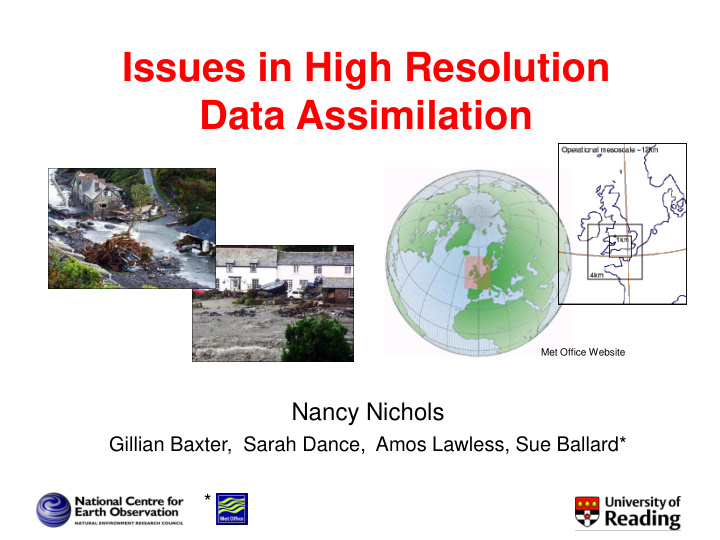



Issues in High Resolution Data Assimilation Met Office Website Nancy Nichols Gillian Baxter, Sarah Dance, Amos Lawless, Sue Ballard* *
NCEO: Delivering world-class science by unlocking the full potential of Earth Observation to monitor, diagnose and predict environmental and climate change, and ensuring that scientific advances translate into public good.
* *
Outline • Motivation • Challenges • Multi-scale Modelling • Summary and Outlook
Hazardous weather and flooding bbc.co.uk bbc.co.uk Observations Heathrow fog, Birmingham tornado Christmas 2006 Data Hydrological 2005 assimilation model Leeds University NWP model Boscastle storm 2004 bbc.co.uk Snow, 2009 Picture from Ross Bannister
• New observation types providing detail on required scales • Operational storm-scale (1.5km) limited area models now expected – possibly higher resolution in future. • Improvements in hydrological models, including increased interest in the use of more sophisticated data assimilation techniques.
Data assimilation on convective scales is a NEW problem – very different in character from assimilation on synoptic scales. What are the challenges?
Challenges 1. Observations 2. Background Covariances 3. Multi-scale Dynamics / Coupled Systems 4. Nonlinearity and Uncertainty 5. Model Reduction
Challenges 1. Observations 2. Background Covariances 3. Multi-scale Dynamics / Coupled Systems 4. Nonlinearity and Uncertainty 5. Model Reduction
Multi-Scale Dynamics Strong dynamical forcings and feedback exist between synoptic and storm-scale systems. In high resolution convective models: • need to update fine-scale information while preserving large scale information • need lateral boundary conditions for nested limited area models from synoptic-scale data • need to retain rapid convergence of all important scales in the optimization algorithm
Question: How are different scales treated in a LAM? • Study aliasing problems in limited area models: examine how different wave lengths are projected onto the limited area analysis, using a simple nested advection-diffusion model. • Examine methods for combining longer wave- lengths from the global model with shorter wave- lengths from the LAM.
Model The 1D linear advection-diffusion equation with periodic boundary conditions for the parent model and the parent analysis for the LAM boundaries. Discretization is explicit time, up-wind advection and centred diffusion. b b In buffer zone: ,
Assimilation System Experimental System • Uses 4DVar • Transforms to spectral space using double- sine control variable transform • Perfect observations at all points • LAM boundary conditions from parent analysis • Davies Relaxation at LAM boundaries • High Resolution LAM = 4 x parent • High Resolution truth = 2 x LAM
Experiment 1 : Long and short waves truth 2 sin( x / 4 ) 2 sin( 2 x ) sin( 8 x ) sin( 16 x ) ~ | f | 2 k LAM domain Power spectrum o observations --- truth --- parent analysis --- LAM analysis
Summary: • Higher resolution allows higher wave-numbers to be captured by the LAM • A large proportion of the “long wave” information is aliased onto wave-number k=1 • Some “long wave” information is aliased onto higher wave-numbers • These conclusions can be shown to hold mathematically for a general case using discrete Fourier transforms
Assimilation in Spectral Space , ,
Background Matrix B B 1 B 2 = diag{1.0,0.5,0.1,0.01,0.005} = diag{0.005,0.01,0.1,0.5,1.0} 2 1 Correlation structure Red = B 1 Blue = B 2
Different weightings in spectral space on background I 0 Σ 1 Σ 1 0 I LAM 0 I domain Σ 1 Σ 1 I 0 Power spectrum o observations --- truth --- parent analysis --- LAM analysis
Conclusions • Wave-lengths shorter than the resolution of the global models can be analysed in the LAM, but longer wave-lengths may be incorrectly represented due to aliasing. • Weighting global background differentially in spectral space can affect scales analysed in LAM model. G.M. Baxter, PhD Thesis , 2009
Further Work - ???
Further Work - ??? • Test methods for combining long wave information from Global models with high frequency information from the Lam via control variable transforms more generally • Improved treatment of boundary conditions • Scale-dependence of 4DVar convergence
Multi-scale systems (2) • Convergence of the inner loop of the Met Office incremental 4DVar data assimilation system at different Fourier scales has been analysed. Multi-level optimization methods are planned for development. • Conditioning of the linearized minimization problem as a function of the length-scales in the background covariances and as a function of the observation variances.
Fourier spectrum of pressure increment at lowest model level as inner loop converges . Faster convergence at large and small scales Log (Power) Final iterate Slower convergence at 1st iterate intermediate scales Wave number
Conditioning of 3DVar Condition Number of (B -1 + HR -1 H T ) vs Length Scale Laplacian 2 nd Derivative Periodic Gaussian Exponential B ij = Blue = no obs Red = with obs variances 0.1 / 0.2
Results: • The Met Office inner loop converges more slowly at mid-wave-lengths. Multigrid approach might improve rates. • Conditioning of inner linear system decreases with the length scales in the background error covariance matrix. • Conditioning is improved by the addition of the observations Haben et al., Internal Reports, 2009
f The Discrete Fourier sine Transform of a function is j N 1 ^ f f sin( πjk/N) j k j 1 where k is the wavenumber and N is the number of gridpoints
Recommend
More recommend